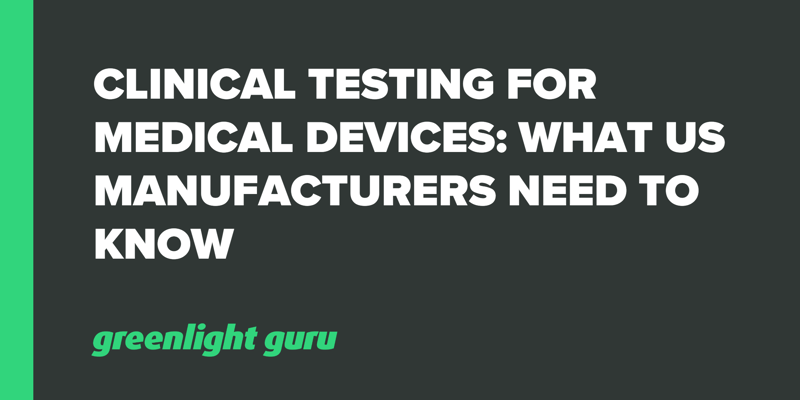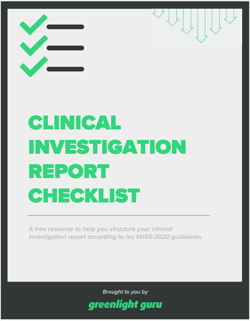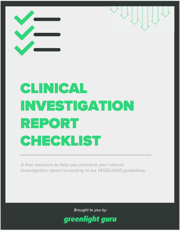Clinical Testing for Medical Devices: What US Manufacturers Need to Know

Clinical testing of medical devices is a critically important step in ensuring the safety and efficacy of medium to high risk products. It’s one of the presumed protections for patients in the US, and as such, is taken extremely seriously by the FDA.
Though not all medical devices require clinical testing before being placed on the US market, many do. And if your medical device company needs clinical data to back up claims of safety and efficacy, it’s essential that you understand the regulations, requirements, and processes involved in clinical testing.
Here’s what you need to know about planning and conducting clinical testing for your your medical device:
Which medical devices need clinical testing?
Under FDA regulations, there are three risk-based classes of medical devices, and each class is subject to different levels of regulatory controls.
Class I medical devices do not require any type of clinical testing. It is also unlikely, though not impossible, that a Class II device will require clinical data as part of a 510(k) submission. Class III devices, however, must have clinical data to support their PMA submission.
But before any clinical tests begin, medical device companies must first apply for and obtain an Investigational Device Exemption (IDE) from the FDA. An IDE gives a medical device manufacturer authorization to conduct a study with human participants using a device of significant risk that has not been approved for the intended use.
Once the IDE is obtained, then the clinical testing process may proceed.
What are the FDA regulations for testing that involves clinical trials?
Clinical testing can vary depending on the type of research being done. Depending on the nature of the research, there are varying degrees of regulatory oversight. On the highest end of that spectrum would be the type that involves human subjects/patients, known as clinical trials.
The goal of a clinical trial is to evaluate whether the treatment, medical device, or intervention is safe and effective for patients. Because clinical trials involve human subjects, it’s of the utmost importance that every aspect of it is designed, executed, and reported as carefully as possible.
To that end, the FDA has outlined what it calls Good Clinical Practices (GCP) in several sections of 21 CFR:
-
21 CFR 812 - Investigational Device Exemptions
-
21 CFR 50 - Protection of Human Subjects
-
21 CFR 56 - Institutional Review Boards
-
21 CFR 54 - Financial Disclosure by Clinical Investigators
-
21 CFR 820, Subpart C - Design Controls of the Quality System Regulation
Medical device companies are required to comply with these regulations in planning and conducting a clinical study.
One related standard you should be familiar with is ISO 14155, which covers the general specifications and requirements for the clinical investigation of medical devices for human subjects.
ISO 14155 contains useful ancillary guidelines for clinical investigations that can help manufacturers design, perform, record, and report clinical trials for medical devices. While ISO 14155 is not a legally binding regulation in the US market, the standard is recognized by the FDA. This means that the FDA will accept clinical trials that have been conducted in accordance with ISO 14155.
What is the difference between feasibility studies and pivotal studies?
There are two types of clinical trials that a medical device may undergo for testing, both of which require an IDE to begin: feasibility study and pivotal study.
Feasibility study
A feasibility study is a small clinical trial, with generally anywhere from 10-40 participants. This does not generate clinical evidence for a marketing application; rather, a feasibility study focuses on patient safety and is an attempt to provide evidence that a pivotal study is warranted. It may also provide a rationale for the modification of a device before moving forward with another study.
Pivotal study
A pivotal study is used to collect clinical data that will help justify the safety and efficacy of the medical device. At this stage, a medical device company is hoping to prove that the benefits of their product outweigh any risks. The data from a pivotal study is used to support a PMA submission to the FDA, and thus is subject to higher levels of scrutiny than the data from feasibility studies.
Keep in mind, one feasibility study does not automatically lead to a pivotal study. A company can go through multiple feasibility studies before advancing to a pivotal study for their device.
Reduce risk for safer, more effective devices with Greenlight Guru Quality
Assessing the risk of a medical device is at the heart of clinical testing, but risk management shouldn’t be reserved solely for clinical trials. A risk-based approach should be incorporated into every part of your product lifecycle—design, development, manufacture, and post-market surveillance. By making risk an integral part of everything you do, you’ll be better prepared for clinical testing when the time comes.
That’s why at Greenlight Guru, we built our QMS software on top of the two pillars of quality and risk management. Our QMS comes with a dedicated Risk Management Software workflow and has FDA and ISO best practices built into every feature, so you spend less time on administration and more time building a safe and effective medical device.
Get your free demo of Greenlight Guru today!
Looking for a design control solution to help you bring safer medical devices to market faster with less risk? Click here to take a quick tour of Greenlight Guru's Medical Device QMS software
Wade Schroeder is a Medical Device Guru at Greenlight Guru with a noticeable enjoyment of medical device product development processes. As an electrical engineer by trade, he began his career developing medical exam procedure chairs and later designing IVD devices. He has been a risk management enthusiast since the...
Related Posts
How to Set Up Clinical Studies to Comply with US FDA Regulations
SaMD Clinical Evaluation: What Do the FDA and IMDRF Say?
Clinical Data Management System (CDMS) for Medical Device Clinical Trials
Get your free resource
Clinical Investigation Report Checklist











